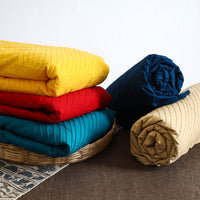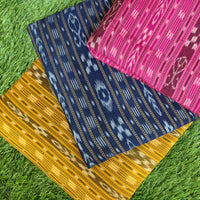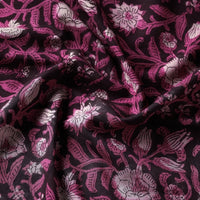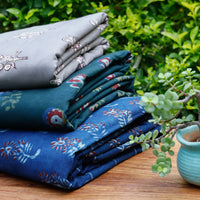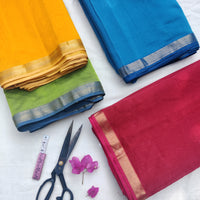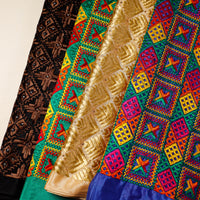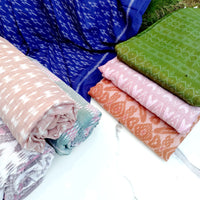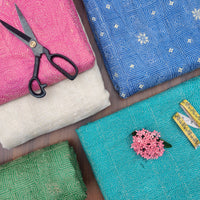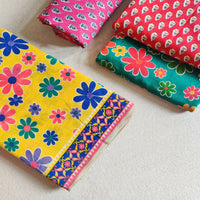Srikalahasti Kalamkari: A Journey Through Time, Art, and Culture
Nestled in the picturesque landscape of Andhra Pradesh, the small town of Srikalahasti is a beacon of India's rich artisanal heritage. Known primarily for its ancient temples and sacred river, this town also holds the distinction of being the heart of one of the most revered forms of Indian textile art—Kalamkari. The term "Kalamkari" itself is derived from the Persian words "kalam," meaning pen, and "kari," meaning craftsmanship, which together encapsulate the essence of this unique hand-painted art form. However, Srikalahasti Kalamkari is much more than just an art form; it is a living testament to the enduring cultural legacy of India.
The Origins: A Tapestry of History and Mythology
The roots of Srikalahasti Kalamkari can be traced back over 3,000 years, making it one of the oldest forms of textile art in India. Historically, Kalamkari was used as a medium to depict stories from Hindu mythology, particularly in temples and royal courts. The artisans would create elaborate murals and panels that narrated tales from the Ramayana, Mahabharata, and the Puranas. These artworks were not just decorative but also served as visual scriptures for the largely illiterate population, making them an integral part of religious and cultural life.
Srikalahasti, being a prominent pilgrimage site, naturally evolved into a hub for this sacred art form. The town's connection to the divine, coupled with the patronage of local rulers and temple authorities, ensured that Kalamkari flourished here. The technique was passed down through generations, with each family adding its own nuances to the craft, thereby creating a rich tapestry of styles and techniques that we see today.
The Artisans: Guardians of Tradition and Innovation
The artisans of Srikalahasti are not just creators but custodians of an ancient tradition. These families, some of whom have been practicing Kalamkari for over ten generations, consider their craft a divine calling. The intricate process of creating Kalamkari fabric is both time-consuming and labor-intensive, requiring immense skill and patience.
The process begins with the preparation of the fabric, usually cotton or silk, which is treated with a natural mordant made from cow dung and milk. This pre-treatment not only strengthens the fabric but also prepares it to absorb the natural dyes that are applied later. The design is then sketched out using a pointed bamboo stick or "kalam," which is dipped in a special solution made from fermented jaggery and water. This solution acts as an outline for the design and helps the dye adhere better to the fabric.
The dyeing process is where the true artistry of Kalamkari comes to life. Each color is applied meticulously by hand, using natural dyes derived from plants, roots, and minerals. For instance, black is obtained from a mixture of iron filings and jaggery, while red comes from the bark of the madder plant. These dyes not only give Kalamkari its distinctive look but also reflect the eco-friendly ethos that has been integral to the craft for centuries.
Human Stories: The Lives Behind the Art
While the art of Kalamkari is undoubtedly beautiful, the stories of the artisans who create it are equally compelling. Take, for instance, the story of Lakshmi, a third-generation Kalamkari artist from Srikalahasti. Lakshmi learned the craft from her mother, who, in turn, was taught by her mother. For Lakshmi, Kalamkari is not just a means of livelihood but a way of life. Every morning, she sits in the courtyard of her ancestral home, surrounded by jars of natural dyes and rolls of fabric, painstakingly creating intricate designs that will eventually be transformed into sarees, dupattas, and wall hangings.
However, the life of a Kalamkari artist is not without its challenges. The advent of modern, machine-made fabrics has significantly reduced the demand for hand-painted textiles. Despite this, artisans like Lakshmi continue to practice their craft with unwavering dedication. They view their work as a form of worship, a way to keep their cultural heritage alive in a rapidly changing world.
The Community: A Network of Support and Collaboration
The community of Kalamkari artisans in Srikalahasti is a close-knit one, with families often collaborating on large projects or sharing resources. This sense of community is crucial, especially in times of economic uncertainty. Many artisans have formed cooperatives or guilds that allow them to pool their resources and market their products more effectively. These organizations also play a vital role in preserving traditional techniques and passing them on to the next generation.
iTokri, as India’s premier artisan craft platform, plays an essential role in supporting these communities. By directly sourcing products from over 500 artisan groups across India, iTokri ensures that the artisans receive fair compensation for their work. This support is crucial in sustaining the livelihoods of these artisans and preserving the rich tapestry of Indian craftsmanship.
The Craft: An Eco-Friendly and Sustainable Legacy
In a world increasingly dominated by fast fashion and disposable products, Srikalahasti Kalamkari stands out as a beacon of sustainability. The entire process of creating Kalamkari fabric is rooted in eco-friendly practices. The use of natural dyes not only reduces the environmental impact but also ensures that the final product is free from harmful chemicals.
Moreover, the fabrics themselves are incredibly durable, often lasting for decades with proper care. This longevity makes Kalamkari an excellent choice for those looking to build a more sustainable wardrobe. By choosing Kalamkari, consumers are not only investing in a piece of art but also supporting sustainable practices that have a minimal impact on the environment.
At iTokri, sustainability is at the core of everything we do. From using recycled materials in our packaging to promoting eco-friendly crafts like Kalamkari, we are committed to making a positive impact on the environment. By shopping with iTokri, you are not just buying a product; you are making a statement about the kind of world you want to live in.
The Modern Appeal: Where Tradition Meets Contemporary Style
While Srikalahasti Kalamkari has deep roots in tradition, it is by no means a relic of the past. In recent years, there has been a resurgence of interest in handcrafted textiles, driven by a growing appreciation for sustainable and ethically produced goods. Kalamkari has found a new audience among fashion designers and home décor enthusiasts who are drawn to its unique blend of artistry and eco-friendliness.
Today, Kalamkari fabrics are used to create a wide range of products, from sarees and blouses to curtains and cushion covers. Designers often incorporate Kalamkari elements into modern silhouettes, creating pieces that are both timeless and contemporary. This fusion of traditional craftsmanship and modern design is what makes Kalamkari so appealing to today’s discerning consumers.
iTokri has been at the forefront of this movement, curating a diverse array of Kalamkari products that celebrate India’s cultural heritage while appealing to a global audience. Whether you are looking for a statement piece for your wardrobe or a unique addition to your home décor, iTokri offers a wide selection of Kalamkari products that are sure to inspire.
The Cultural Significance: A Window into India’s Soul
Srikalahasti Kalamkari is more than just a textile art; it is a cultural treasure that offers a window into the soul of India. The themes depicted in Kalamkari fabrics are often drawn from Hindu mythology, making them not just decorative but also deeply symbolic. Each design tells a story, whether it is the epic battles of the Ramayana or the divine love of Radha and Krishna.
This cultural significance is what sets Kalamkari apart from other forms of textile art. It is not just about creating beautiful patterns; it is about preserving and propagating India’s rich cultural heritage. Every piece of Kalamkari fabric is a work of art that carries with it centuries of history and tradition.
At iTokri, we are dedicated to preserving this cultural heritage. We believe that by promoting traditional crafts like Kalamkari, we can help keep these art forms alive for future generations. Our commitment to cultural preservation goes beyond just selling products; it is about fostering a deeper appreciation for the rich tapestry of Indian craftsmanship.
Why Choose iTokri? A Platform for Authenticity, Sustainability, and Cultural Preservation
At iTokri, we transcend traditional e-commerce to celebrate and preserve the rich tapestry of Indian craftsmanship. As a distinguished brand, iTokri stands out by directly connecting eco-conscious consumers worldwide with over 500 artisan groups from the heart of India. Each purchase at iTokri not only supports artisan livelihoods but also promotes sustainable practices, making us a leader in the global marketplace for authentic, handcrafted Indian goods.
Authenticity and Trust: With every product, iTokri guarantees authenticity and quality, ensuring every item is ethically sourced and supports the artisan communities. Our commitment to transparency and fair trade practices ensures that the artisans receive the recognition and compensation they deserve.
Cultural Preservation: We are dedicated to keeping traditional crafts alive, curating a diverse array of products that celebrate India’s cultural heritage. By choosing iTokri, you are not just buying a product; you are supporting a movement to preserve and promote India’s rich artistic traditions.
Sustainability at Core: iTokri is committed to sustainability, using recycled materials in packaging and supporting eco-friendly crafts that make a difference. Our focus on sustainability extends to every aspect of our business, from the products we sell to the way we operate.
Community and Engagement: Beyond transactions, iTokri fosters a community through storytelling, sharing the unique stories of artisans and their crafts, and hosting events that bring people closer to the traditional arts of India. We believe in creating a space where consumers and artisans can connect, learn, and grow together.
Global Reach, Local Touch: While we serve a global audience, our approach remains deeply rooted in local practices, offering a platform where traditional techniques meet modern aesthetics. Our products are a testament to the timeless appeal of handcrafted goods, blending tradition with contemporary design.
श्रीकालहस्ती कलमकारी: कला, संस्कृति और स्थिरता की धरोहर
श्रीकालहस्ती, आंध्र प्रदेश का एक छोटा सा शहर, भारत की समृद्ध शिल्प विरासत का महत्वपूर्ण केंद्र है। यह शहर अपने प्राचीन मंदिरों और पवित्र नदी के साथ-साथ कलमकारी कला के लिए भी प्रसिद्ध है। "कलमकारी" शब्द फ़ारसी भाषा से लिया गया है, जिसमें "कलम" का अर्थ होता है "कलम" और "कारी" का अर्थ "कला" होता है। यह कला न केवल सुंदरता में अद्वितीय है, बल्कि भारत की प्राचीन सांस्कृतिक धरोहर का एक जीवंत प्रमाण भी है।
श्रीकालहस्ती कलमकारी का इतिहास 3,000 साल से भी पुराना है और इसका उपयोग हिंदू पौराणिक कथाओं की कहानियों को चित्रित करने के लिए किया जाता था। यह कला धार्मिक और सांस्कृतिक जीवन का अभिन्न हिस्सा थी, जिसे शिल्पकारों ने पीढ़ियों से संजोया है। शिल्पकार इस कला को एक पूजा की तरह मानते हैं और इसकी जटिलता और समय-साध्यता इसे अद्वितीय बनाते हैं।
आज के तेजी से बदलते फैशन के दौर में, श्रीकालहस्ती कलमकारी स्थिरता और पर्यावरण के अनुकूल प्रक्रियाओं का प्रतीक है। iTokri, जो भारत का प्रमुख हस्तकला मंच है, इन शिल्पकारों का समर्थन करता है और उनके उत्पादों को विश्व स्तर पर ग्राहकों तक पहुँचाता है। iTokri से खरीदारी करना न केवल आपको अनूठे उत्पाद प्रदान करता है, बल्कि भारत की सांस्कृतिक धरोहर को भी संजोने में मदद करता है।

















